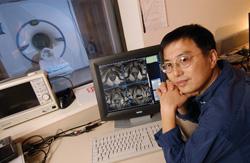
November 9, 2011 – A new study found that spinal bleeding is found often in young children who are victims of abusive trauma. The findings support performing complete spine imaging for children undergoing brain magnetic resonance imaging (MRI) for moderate or severe traumatic brain injury and suggest a pathway for distinguishing between abusive and accidental injury. The study is published online in the journal Radiology.
According to the researchers, abusive head trauma is the leading cause of significant traumatic brain injury in infants, with a 20 to 38 percent mortality rate and significant neurological and developmental impairment in 30 to 78 percent of survivors.
The radiologic features of abusive head trauma include bleeding within the skull and brain injury. Spinal injuries like spinal subdural hemorrhage — bleeding in the space between the spinal cord and its tough outer membrane — are another feature of trauma that may be overlooked clinically in non-fatal cases because of coexistent brain injury and traumatic coma.
“Imaging the whole spine is important in cases of abuse for two reasons,” said study author Arabinda Kumar Choudhary, M.D., MRCP, FRCR, pediatric radiologist at Penn State Milton S. Hershey Medical Center and Penn State College of Medicine in Hershey, Pa. “Most of the spinal injuries in abusive head trauma are clinically silent because of extensive injuries elsewhere and lack of a clinical history suggestive of spinal injury. It is important to rule out any significant injury to the spine and spinal cord. Also, spine imaging allows complications of subdural hemorrhage collecting in the spinal canal to be diagnosed earlier.”
To study the incidence of spinal subdural hemorrhage, Choudhary and colleagues looked at clinical data and imaging records for 252 children aged two years old or younger who underwent treatment for abusive head trauma at the medical center. Imaging results included computed tomography (CT) and MRI of the brain, spine, chest, abdomen and pelvis. They compared the imaging results to those from a group of 70 similarly aged children who were treated for accidental trauma.
Spinal canal subdural hemorrhage was evident in more than 60 percent of the children with abusive head trauma who underwent thoracolumbar imaging, or imaging of the thorax and the lumbar regions of the spine. In contrast, spinal canal subdural hemorrhage was rare in accidental trauma. Only one of the 70 children in the accidental trauma group had spinal subdural hemorrhage.
Choudhary indicated that more research is needed to improve understanding of the relationship between abusive trauma and spinal bleeding and provide another tool for criminal investigators.
“The diagnosis of abusive head trauma is complex,” Choudhary said. “In most of these cases, the history does not fit with the clinical findings. The pathophysiology and diagnosis of abusive head trauma are still being hotly debated, particularly in the courts.”
Choudhary added that it is crucial for radiologists to have all the facts at their disposal to be able to come to a confident diagnosis in possible cases of abusive head trauma. “The more we understand the diagnosis and the more research we have in this area, the better we will be at serving our most vulnerable patients,” he said.
For more information: RadiologyInfo.org.


 December 10, 2025
December 10, 2025 









